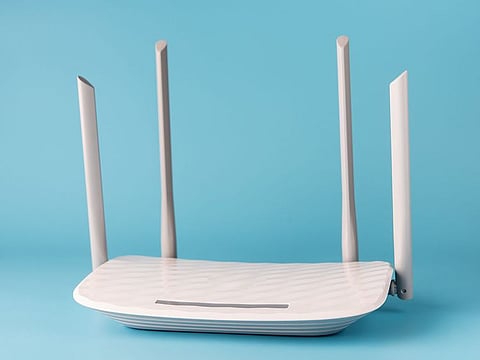If I’m stuck with WiFi 4, can I jump to WiFi6 straight away?
Here’s how to find out when it’s time for an upgrade

There’s nothing more exasperating than a defiant Wi-Fi connection disrupting your online submission. But don't despair, a solution is within reach.
Work, assignments, movie streaming, intense gaming, and a multitude of tasks all contend for their share of that valuable bandwidth on the bustling network.
A good Wi-Fi router, one that maximises your home or office fibre connection, can unlock the full potential of your existing internet speed, extend the network's coverage, and bolster the security of your wireless devices.
Embarking on this journey might present some initial challenges, but fear not, as state-of-the-art routers are readily available and poised to enhance your online experience with increased speed and capacity.
Some advanced routers even go the extra mile — by offering the advantage of prioritising your device on the network. The question then arises: How can you determine if your router is in line with your need for speed, and how can you break free from the frustrating clutches of a sluggish connection?
Here’s a simple way to know whether you’re stuck with WiFi4, how it affects you, and when it’s time to upgrade:
WiFi 4/5/6/7: What’s the most dominant today?
WiFi 4 and WiFi5 remain the dominant router technology in most parts of the world, according to Speedtest Intelligence data.
With WiFi 6 representing just under 10% as of February 2023, and WiFi7 showing very few samples, there is a long way to go before WiFi 6 becomes a dominant standard globally, according to Speedtest.
A trend continues, however, showing the share of samples from WiFi 4 routers falling by 6 per cent year-over-year, while WiFi5’s share of samples has increased, according to Speedtest.
Where do I start?
Begin by examining your router: even with the latest devices, you might still be stuck on Wi-Fi 4. Even if, as a consumer, you own modern smartphones and Wi-Fi routers, you may still unknowingly use Wi-Fi 4 due to device “misconfiguration” and coverage constraints.
WiFi 4/5/6/7: What’s the difference?
As you can see, there’s a world of difference — more than 10-fold — between WiFi 4 (up to 600 Mbps) and WiFi 5 (up to 7 Gbps). So if you’re stuck with WiFi 5, perhaps an upgrade to WiFi 5 may be warranted, especially if the price difference between a WiFi 5 and WiFi 6 routers would blow a hole in your pocket. There are many router makers, however, that offer compability across the next-generation WiFi.
How to check if you’re stuck with WiFi
The best way to check whether you’re stuck with Wi-Fi 4 (also known as 802.11n), is to look at the documentation that came with your router — to see whether it supports a more recent Wi-Fi standard, including Wi-Fi 5 (802.11ac), Wi-Fi 6 (802.11ax), or Wi-Fi 7 (802.11be).
Connecting your smartphone or digital device to the router is another story, though.
Karim Yaici, Lead Industry Analyst at Ookla covering the Middle East and Africa (MEA), explained: “There’s no universal easy method to determine what Wi-Fi standard your smartphone connecting to your router is using, however both Windows and Mac computers will allow you to view this in network settings.”
"As a rule, if you have a fibre broadband connection supporting multiple hundreds of Mbps, but your maximum Wi-Fi speed is 100 Mbps while you’re located close to your Wi-Fi router, then you're likely connected using Wi-Fi 4,” he said.
If I’m using WiFi4, can I jump to Wi-Fi 6 straight away?
Yaici also offers the following advice: “If the router is old and does not support Wi-Fi 6 (802.11ax), the only option is to upgrade. Your first option here should be to contact your ISP to see what they can offer you.”
Internet service providers (ISPs) are the main driver behind the adoption of new Wi-Fi standards: rolling out more advanced routers to their customer bases enables them to take advantage of the increased performance of newer generations of Wi-Fi technology, and helps to ensure ISPs deliver faster speeds, particularly over fibre access networks.
CHANGING ROUTER SETTINGS
In case you have a modern router that supports Wi-Fi 6 but continues to operate on Wi-Fi 4, a change in the setting in the router is needed. But you must also ensure that the devices you are trying to connect to support Wi-Fi 6. In addition to providing newer routers, ISPs are increasingly positioning to help consumers solve Wi-Fi performance issues in the home, such as offering mesh Wi-Fi solutions. For some ISPs, this has even taken precedence over offering newer as they look to improved coverage within the home as a faster route to improving Wi-Fi performance.
What’s the cost difference of migrating to WiFi 5 or WiFi 6?
All current routers provided by ISPs in the region support Wi-Fi 5 and many of them support Wi-Fi 6. These are usually bundled for free with a fixed broadband subscription so there is no additional cost to the consumer.
However, if you're automatically upgraded year-on-year, you may still be using an old router, in which case you need to ask your ISP to provide you with a newer router or buy a new one.
Wi-Fi 6 routers were first introduced in 2019, and have fallen in price since then, so upgrading to this newer Wi-Fi standard should not be prohibitively costly, but will vary by market.
Some takeaways:
Sign up for the Daily Briefing
Get the latest news and updates straight to your inbox







